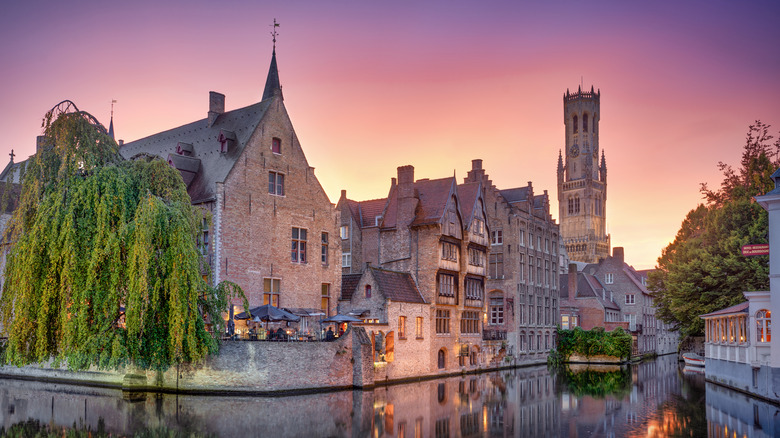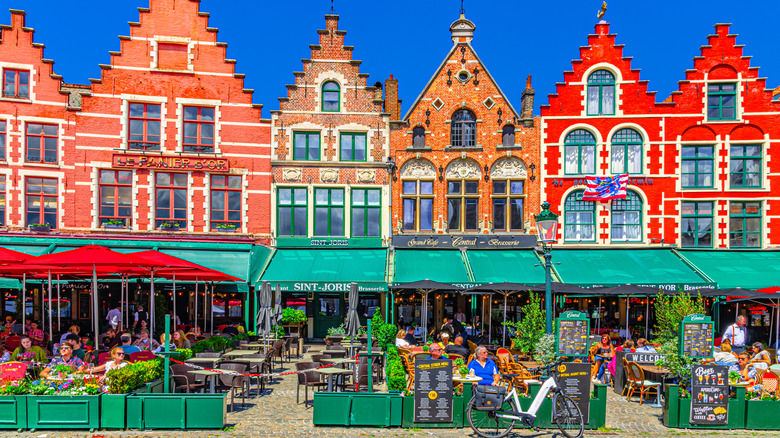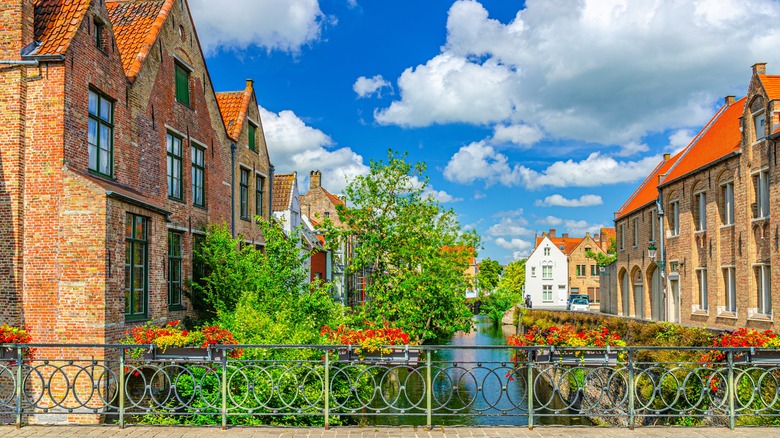Europe's Most Walkable City Is A Medieval Enclave Straight Out Of A Fairytale Called 'Venice Of The North'
While Bruges has a bit of a reputation as a mecca for beer enthusiasts, it's also a beautiful and petite city, with many of its loveliest sights all within easy walking distance. So easy, in fact, that travel site Motel One has ranked Bruges first in its list of Europe's most walkable cities. But even better, much of Bruges' historic center is linked by pretty canals, leading some to call it the "Venice of the North." But if that sounds familiar, it may be because the "Venice of the North" moniker has been attached to other cities like Amsterdam, St. Petersburg, and Hamburg, the city with the most bridges in Europe.
You can arrive in Bruges via the local Ostend-Bruges International Airport, but it only offers a short list of European destinations. Therefore, the main Brussels Airport is likely a better option for most travelers, as there are a variety of connections, including one of Europe's newest sleeper train routes, which connects to Amsterdam, Munich, and more. There are numerous options to get to Bruges, including driving, which takes approximately one hour and 10 minutes. But a better option is to stay a day or two in Brussels, before connecting to Bruges on the direct train from Brussels Midi Train Station, a route that takes a little under one hour to complete.
To see a bit more of Belgium, consider breaking up the journey with a stop in Ghent, a city with just as much charm as Bruges but without the crowds. Ghent is approximately halfway between Brussels and Bruges, so expect the journey to take around 25 minutes to Gent-Sint-Pieters station.
Touring Bruges' most notable sights on foot
To get your bearings, begin in the ornate Markt Square, to see the collections of historic architecture and cafes. Pay particular note to the colorful stepped gable-roofed houses and the towering 272 feet tall 13th-century belfry, its roof reachable by 366 steps. The effort is more than worthwhile for the panoramas of Bruges from the top. If you happen to be in Bruges on a Wednesday or the weekend, visit Markt Square from 11:00 a.m. to listen to the melodious chimes of the tower's 47-bell Carillon.
A short stroll east leads to the Burg Square, where you'll find the ornate Bruges City Hall, a stunning example of late-Gothic architecture built between 1376 and 1421. Just a few steps away is the dark facade of the Basilica of the Holy Blood, so called because it's said the church houses a holy vial, containing a cloth stained with the blood of Christ. From the church, it's a picturesque stroll towards the Rozenhoedkaai, or the Rosary Quarter, the intensely romantic spot where the Dijver and Groenerei canals meet. Visit here in the evenings to see Markt Square's towering belfry and those antique old quarter houses reflected in the water, along with the ember-like glow of the city's atmospheric lighting.
Take a leisurely stroll along the Dijver Canal to find the winsome Bonifaciusbrug (Boniface Bridge). The bridge is petite and like something from a fairytale, with the greenery growing across its walls, and it has a good view of those half-timbered houses, synonymous with Bruges, as well as the imposing Church of Our Lady.
Exploring Bruges via the water
Bruges' canals cut attractive lanes through the medieval city, flanked by ornate houses and scenic parks, and are ideal for sightseeing. Boat trips run throughout the summer months (with daily sailings between March and November), from several points in the old center and provide a beautiful, laid-back antidote to any sore feet gained from hikes on those ancient city cobbles. The tours on offer all slightly differ (though each of the companies utilizes similar all-electric boats), but you'll see highlights like Jan van Eyckplein (Jan van Eyck Square) and the 13th-century Begijnhof and its delightful gardens.
To continue your tour of Bruges' canals on foot, we suggest a diversion to the idyllic Augustijnenrei, which is home to one of the oldest bridges in Bruges: the 14th-century Augustine Bridge. For a more modern side of the city, take a peek at Coupure, which links to Ghent and is usually lined with pleasure boats, and is a popular spot for swimming in the summer.
To see a little of Bruges' green side, head over to the lovely Minnewater, which was historically a dock for trade ships, but is now a scenic body of water referred to in English as the Lake of Love, owing to a romantic legend attached to the lake. You'll find it flanked by the lush Minnewaterpark, home to the charming Minnewater Castle, a serene spot for an afternoon stroll away from the crowds.


